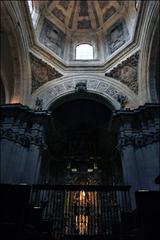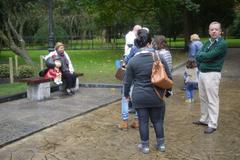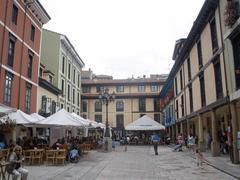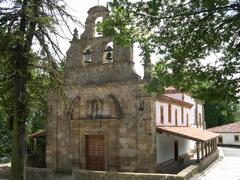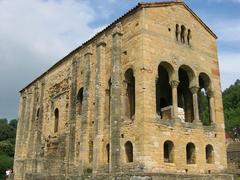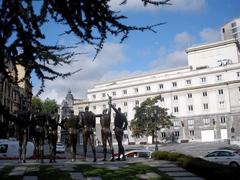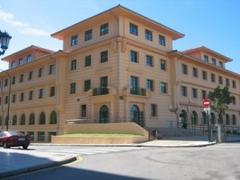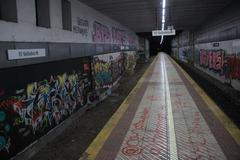Estadio Carlos Tartiere Visiting Hours, Tickets & Guide to Oviedo Historical Sites
Date: 14/06/2025
Introduction
Estadio Carlos Tartiere is a prominent landmark in Oviedo, Asturias, embodying nearly a century of football tradition, architectural innovation, and community pride. As the home of Real Oviedo and a witness to major Spanish football events—including the 1982 FIFA World Cup—the stadium is not only a thrilling venue for sports enthusiasts but also a cultural destination. This detailed guide covers everything you need to plan your visit, from historical highlights and architectural evolution to practical advice on tickets, guided tours, accessibility, and nearby Oviedo historical sites.
Table of Contents
- Historical Overview
- Visiting Estadio Carlos Tartiere
- Matchday Experience
- Nearby Oviedo Historical Sites
- Visitor Tips
- Frequently Asked Questions
- Conclusion
- Sources
Historical Overview
Origins and Early Development (1932–1950s)
Estadio Carlos Tartiere began as Estadio de Buenavista, inaugurated in 1932 in the Ciudad Jardín neighborhood (Real Oviedo). The opening match between Spain and Yugoslavia marked the stadium’s significance, with Isidro Lángara scoring the first goal. Initially accommodating 15,000 spectators, its innovative design included Europe’s first 100-meter covered stand without supporting pillars, providing unobstructed views (El Sitio De Mis Cromos).
The Spanish Civil War left the stadium in ruins, but restoration, supported by a government loan, revitalized the venue and allowed football to flourish again in Oviedo.
Naming and Municipalization
In 1954, the Oviedo City Council acquired the stadium, and in 1958, it was officially named Estadio Municipal Carlos Tartiere to honor Real Oviedo’s founder and first president (Real Oviedo). This solidified its identity as a civic landmark.
Architectural Evolution and Modernization
Significant upgrades arrived in 1969 with the addition of floodlights, and in 1982 the stadium was rebuilt for the FIFA World Cup, expanding capacity to 23,500 and updating facilities to international standards (Wikipedia; Real Oviedo). The main stand was covered, and infrastructure modernized.
Role in National and International Football
The stadium hosted three matches during the 1982 World Cup and several Spanish national team fixtures. It was also central to Real Oviedo’s European debut in 1991 (El Sitio De Mis Cromos; Real Oviedo).
Cultural and Community Significance
Beyond football, Carlos Tartiere served as a venue for significant cultural events, such as Michael Jackson’s 1992 concert, and was a community hub for gatherings and celebrations (Wikipedia). It remains a symbol of Oviedo’s resilience and identity.
Decline, Replacement, and Legacy
By the late 1990s, the stadium’s capacity was reduced, prompting construction of the new Estadio Carlos Tartiere, which opened in 2000 just 600 meters from the original site (StadiumDB). The old venue was demolished in 2003 and replaced by the Palacio de Exposiciones y Congresos Ciudad de Oviedo (Real Oviedo). The modern stadium continues the legacy—Asturias’ largest, seating 30,500, with advanced architecture and amenities (StadiumDB).
Visiting Estadio Carlos Tartiere
Location & Accessibility
The stadium is located at C/ Ricardo Vázquez Prada, 33013 Oviedo, about 2 km from Oviedo’s historic center and easily reachable by foot in 25–30 minutes or via public transport (Stadium Guide). Bus lines L1, L11, and F1 serve the stadium area, and it is a short taxi ride from the train station. Limited parking is available, so public transport is recommended on match days.
Visiting Hours
- Stadium Tours: Generally available Tuesday–Saturday, 10:00 AM–6:00 PM, on non-match days.
- Museum: Open Monday–Friday, 10:00–14:00 and 16:00–19:00; closed on match days and public holidays (LaLiga.com).
- Match Days: Gates typically open 60–90 minutes before kickoff.
Check the official Real Oviedo website for the latest information.
Tickets and Entry
- Match Tickets: Buy online via the Real Oviedo website, at the club store in Modoo Shopping Centre, or at stadium windows (two hours before kickoff; subject to availability).
- Tours: Reserve in advance online or by contacting the club.
- Entry: Security checks are in place. Digital tickets (NFC) are accepted.
Stadium Tours and Museum
Guided tours offer behind-the-scenes access to locker rooms, tunnels, press areas, and the pitch. The Real Oviedo museum displays trophies, memorabilia, and stories of legendary players (LaLiga.com).
Facilities & Services
- Seating: Stadium seats 30,500, with most stands covered.
- Accessibility: Ramps, elevators, and accessible restrooms are available. Notify the club in advance for assistance.
- Food & Beverage: Concessions serve snacks and Asturian specialties; local bars nearby add to the experience.
- Merchandise: The club shop inside the stadium offers official gear.
Matchday Experience
Pre-Match Atmosphere
Arrive early to join local fans (“Carbayones”) in nearby bars and plazas. Expect singing, flag-waving, and Asturian cider flowing—a true festival of football culture.
Supporter Culture
The Fondo Norte (“Grada Azul”) is home to the most passionate supporters, with organized chants, drums, and tifos. The club anthem rings out before every match, creating a sense of unity and excitement.
Food and Beverage
Try bocadillos de chorizo, empanadas, and local cider. Reasonably priced concessions are available inside, with richer options in nearby eateries.
Family-Friendly Features
Designated family areas ensure a welcoming environment for all ages. Weekend matches may feature children’s activities and mascot appearances.
Safety and Regulations
Bag checks and security are standard. Smoking is prohibited in stands, and alcohol is regulated. Medical facilities and evacuation routes are well-marked.
Nearby Oviedo Historical Sites
Enhance your visit by exploring these nearby landmarks:
- Cathedral of San Salvador: Gothic masterpiece in the city center.
- San Miguel de Lillo & Santa María del Naranco: UNESCO-listed pre-Romanesque churches.
- Museum of Fine Arts of Asturias: Major regional art collections.
- Campo de San Francisco: Relax in this central urban park.
- Plaza del Fontán: Lively market and social hub.
Visitor Tips
- Arrive Early: Enjoy the pre-match atmosphere and avoid queues.
- Weather Preparedness: Asturias’ weather is unpredictable—bring a raincoat or layers.
- Transport: Use public transport or walk to avoid parking issues.
- Learn a Chant: Participating adds to the sense of belonging.
- Try Local Food: Don’t miss the cider!
- Check Schedules: Confirm tour and match times on the official website.
Frequently Asked Questions (FAQ)
What are the Estadio Carlos Tartiere visiting hours?
Tours are usually available 10:00–18:00, Tuesday–Saturday. Museum hours: Monday–Friday, 10:00–14:00 and 16:00–19:00. Check the website for up-to-date info.
How do I buy tickets?
Tickets are available online, at the club store, and at stadium ticket windows.
Is the stadium accessible?
Yes, with ramps, elevators, and adapted facilities. Contact the club for specific needs.
Are guided tours available?
Yes, with advance booking recommended.
What public transport options can I use?
Bus lines L1, L11, and F1; the stadium is also walkable from the city center.
Conclusion
Estadio Carlos Tartiere stands as a vibrant symbol of Oviedo’s sporting heritage, community spirit, and architectural progress. Whether you’re a devoted football fan or a traveler keen on Oviedo’s cultural treasures, the stadium offers a memorable, inclusive experience. Plan ahead, secure tickets, and immerse yourself in local passion—both on match days and while exploring the surrounding historical sites.
Call to Action
Download the Audiala app for real-time updates, exclusive content, and interactive maps. Stay connected on social media, and check out our travel guides to discover more about Oviedo’s rich history and football culture.


